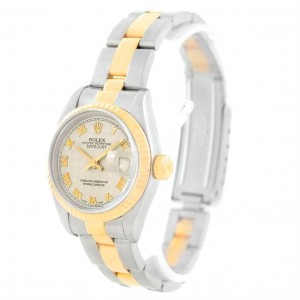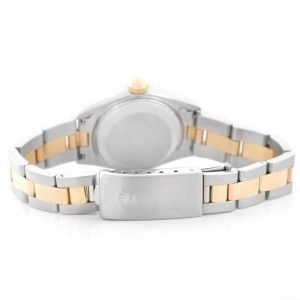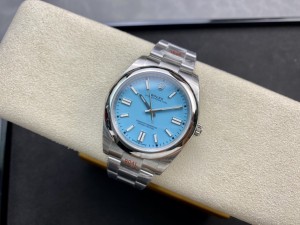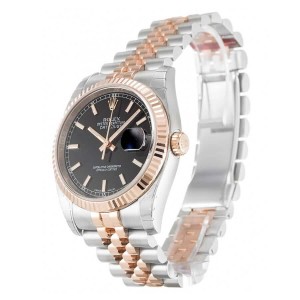Last week, I published a detailed history of the Rolex Turn-O-Graph and Rolex Thunderbird, but I’ve been revisiting and expanding that article daily since its release. If you haven’t read it yet, I highly recommend checking it out. In the process, I stumbled upon a remarkable discovery that I believe is significant for Rolex collectors and enthusiasts. 
For years, it was widely believed that the first Rolex replica watch to feature Solid End Links (SEL) on its Oyster bracelet was the yellow gold Rolex Submariner (Reference 1680), which debuted in 1969. In this early 1970s brochure (shown above), you can see both the stainless steel Submariner (Reference 1680) and the yellow gold variant, as well as the first commercially available Rolex Sea-Dweller (Reference 1665). It’s also worth noting that the diver in the image is T. Walker Lloyd, a legendary deep-sea diver and Rolex executive.
In 1967, Rolex introduced the Submariner Date (Reference 1680), but it did not feature Solid End Links. The stainless steel version became incredibly popular, and two years later, Rolex launched the premium yellow gold Submariner in 1969, marking the first appearance of Solid End Links alongside several other distinguishing features, such as nipple indices. 
However, I’ve recently uncovered evidence suggesting that an earlier Rolex model, a Datejust, may have featured Solid End Links long before the 1969 Submariner. Based on the design language of the replica watch, I believe this replica Rolex Datejust dates back to the late 1950s or early 1960s. The presence of dauphin hands, the applied sans-serif “ROLEX” logo, and sharply pointed 5-minute markers on the dial are key indicators of this timeline.
When I shared my discovery with Nick Gould, he speculated that this could be a prototype, possibly one of the early pieces that René-Paul Jeanneret might have released, as he was known for letting prototypes “slip into the wild.”
At first glance, the photo (above) might appear to show an optical illusion, but I don’t think it is. If you examine the center link of the bracelet closely, the end of the Solid End Link is clearly raised, much like the modern Rolex Oyster bracelets with SELs, and it’s secured by a pin and rivet, further confirming its design. 
To clarify, let me provide context: the image below from Craft and Tailored shows a 1958 Rolex Datejust Turn-O-Graph (Reference 6609) mounted on a yellow gold riveted Rolex Oyster bracelet. This bracelet lacks Solid End Links, which are flat and flush with the outer links, joining the bracelet to the end link. This is the standard for the time, and it’s quite different from the SEL design in the earlier discovery.
Another interesting point is that the SEL Datejust is on a riveted Rolex Oyster bracelet, which predates the yellow gold Oyster bracelet introduced on the 1969 yellow gold Submariner. As shown in the image below, the early Submariner bracelets were not riveted but featured the more modern milled Oyster design.
As an aside, I’ve always been a fan of the first-generation yellow gold Submariners with cobalt blue dials and matching bezel inserts. These models, complete with nipple indices, remain among my favorite vintage Rolex sports models – they’re truly magnificent. 
To further establish a clearer timeline for the SEL Datejust, I’ve included a photo of a 1957 Rolex Datejust with the Thunderbird bezel insert. This model features a similar dial and hands to the SEL Datejust, with the same applied Rolex logo and lumed dauphin hands. It was auctioned by Christie’s in 2015 and provides valuable context for understanding the design evolution. This Reference 6609 was made in 1957, helping to narrow down the possible period for the SEL Datejust.
Seeking additional insights, I reached out to Cameron Barr from Craft & Tailored, who brought up an important clarification regarding the term “Solid End Link.” SEL can refer to two different things. The term is typically used to describe a center end link that’s solid in both construction and appearance, like the one seen in the photo. However, Cameron pointed out that in the early days of the fake Oyster bracelet, end pieces were often stamped, especially in yellow gold, which is softer and prone to damage.
Over time, clone Rolex began to improve these end links, making them appear more solid, even if they were still stamped. This was the case with the first-generation yellow gold Submariner models, which had end links that looked solid but were actually stamped. A few years later, Rolex started milling the end links from two separate pieces, and around 2011, they began to machine them from a single solid piece of metal. The result was a much more durable and robust construction, which remains the standard today. 
The Rolex Datejust I discovered seems to feature a center end link that is genuinely milled or machined, as evidenced by its side profile. This could mean that Rolex was experimenting with solid construction techniques earlier than we had previously thought.
This discovery raises new questions about Rolex’s design evolution, particularly regarding the integration of Solid End Links into their Oyster bracelets. It’s an exciting find that could significantly alter our understanding of Rolex’s history.